How to Prepare Your FinTech for Annual Compliance and MLRO Reporting… Without Pausing All Other Projects
This is the time of the year when many FinTech startups are writing up various mandatory reports and preparing for annual reviews and inspections.
Compliance reporting generates and keeps up-to-date a lot of mandatory documents that you send to your board, investors, regulators, and auditors, but despite the fact that this activity is regular, it usually gets worse instead of getting better and more efficient over time.
Most struggling compliance officers, unfortunately, fall into the same trap: the longer they practice compliance reporting, the more time they need (and not just for themselves, but also for other teams that are supposed to contribute). Misery loves company.
It happens every time, when you don’t follow a clear and simple structure of what to disclose and in which order, and you reinvent your reporting during each reporting cycle, “trying to make it better”.
It’s very similar to a renovation project that does not have clear boundaries. It feels like you can never complete it, it’s never good enough, there is always more to do and more things to fix, and at some point, you just have to quit it because you’ve had enough, it took forever, and way beyond your original budget.
How do you know you lack FOCUS and are at risk of missing your TARGET with compliance formalities?
- You created a list of what needs to be done by the year-end, and at each executive meeting the list gets longer and longer and you find more things to do, but nothing actually gets done.
- You feel like you cannot find the right “owner” for this project within your company and for some reason, you believe that you need one.
- Your compliance team has declined, delayed, or denied clients or project feedback, business support, or otherwise ignored revenue-generating requests because they need to “focus on annual reporting” for the next few weeks.
- Everyone is involved in this compliance reporting emergency (including finance, HR, engineering, and customer support teams) and it feels like everyone is running out of time, money, and patience; and nobody currently has any clear ideas on what to prioritize or what’s the right level of details: is it a 5-pager or 500-pager challenge?
To support you all and save you from unnecessary headaches, I have created this specific workshop that covers all core requirements and disclosures that must be included in your FinTech startup’s annual compliance and MLRO reporting. Once you master this structure, you can re-use previously created documents and never overthink what else to say in each section.
What you’ll get:
The LIVE training taking place on March 21st, 2023, at 1 PM CET), and will cover:
- Annual MLRO reporting, key reportable AML metrics to help you prepare for AML audits;
- Annual Risk Assessment (template included) and Risk Acceptance Framework
- Execution of the Compliance Plan (template included)
- Effectiveness of the Internal Controls Framework
- Reporting incidents and special events (Covid, Brexit …)
- Reporting gaps, deficiencies, and exceptions (recently added section)
INCLUDED TEMPLATES:
- Annual MLRO Report Sample
- Annual Enterprise Risk Assessment Template
- Annual Compliance Plan Execution Template
- Sample disclosures on the Effectiveness of the Internal Controls
- Sample Disclosures for incidents and adverse events reporting
If your compliance team has been ignoring you, hiding somewhere far away and telling you that they need to prepare for their annual reporting which is why everything else must wait for many weeks – just tell them that you care about them very much and suggest that they will feel much more prepared and confident after they register here!



